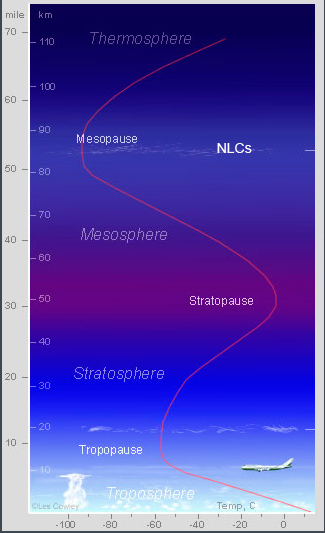NLCs over Dubna, Russia
NLCs over Dubna, Russia: A Mesmerizing Atmospheric Phenomenon
Noctilucent clouds (NLCs) have long captivated the imagination of skywatchers with their ethereal beauty. One such enchanting display occurred over Dubna, Russia, a bustling hub for physics research located approximately 50 miles north of Moscow. The event offered a breathtaking glimpse into the wonders of the Earth's atmosphere and left observers in awe. Let's delve deeper into the fascinating world of NLCs and explore the unique spectacle witnessed over Dubna.
NLCs owe their luminosity to sunlight reflecting off their icy particles. These mesmerizing clouds reside at an astonishing altitude of 50-53 miles, far above typical weather phenomena. What makes NLCs truly captivating is their ability to remain illuminated by the sun even after it has set at ground level. This remarkable phenomenon occurs during summer when these clouds bask in sunlight long after twilight has descended on Earth's surface.
Composed of minuscule ice crystals measuring a mere 1/10,000 mm across, NLCs form in a layer slightly below the mesopause. The mesopause is the coldest part of our planet's atmosphere, with temperatures plummeting below -125 degrees Celsius. These extreme conditions facilitate the formation of delicate ice crystals that give NLCs their characteristic appearance.
The enchanting display of NLCs over Dubna, Russia, left observers spellbound. Alex Tudorica, an avid skywatcher, captured this awe-inspiring phenomenon through his lens, offering a glimpse into the surreal beauty of the night sky. The images depict the delicate tendrils and intricate patterns woven by the NLCs, painting the heavens with their ethereal glow.
While NLCs are a captivating sight to behold, they also hold scientific significance. These clouds act as a valuable indicator of changes occurring in Earth's upper atmosphere. Scientists study NLCs to gain insights into the complex interactions between meteorology, climate, and atmospheric dynamics. By monitoring the occurrence and characteristics of NLCs, researchers can better understand the intricacies of our planet's atmospheric processes.
NLCs are relatively rare, typically limited to high latitudes during the summer months. However, their frequency and visibility have been increasing in recent years. Scientists speculate that this may be due to a combination of factors, including climate change and the rise in greenhouse gas concentrations. The study of NLCs provides valuable data for climate scientists striving to comprehend the impacts of human activities on our planet's delicate atmospheric balance.
Dubna, with its proximity to Moscow and its bustling physics research center, provided an ideal vantage point for observing NLCs. Skywatchers and scientists alike flocked to this location to witness the captivating dance of light and ice in the night sky. The event in Dubna served as a reminder of the beauty and complexity that lies above us, urging us to marvel at the mysteries of our atmosphere.
In conclusion, the NLCs observed over Dubna, Russia, offered a mesmerizing spectacle that captivated both skywatchers and scientists. These ethereal clouds, composed of delicate ice crystals and situated at extreme altitudes, illuminate the night sky long after sunset. By studying NLCs, scientists gain valuable insights into Earth's upper atmosphere and the intricate interplay between climate, meteorology, and atmospheric dynamics. The event in Dubna serves as a testament to the awe-inspiring beauty of our planet's atmospheric optics and encourages us to cherish and protect our delicate celestial canvas.

Noctilucent Clouds at Dubna, Russia. Dubna, some 50 miles north of Moscow, is a major centre for physics research. Image by Alex Tudorica. �Alex Tudorica, shown with permission.

Noctilucent clouds shine by reflecting sunlight. They are 50-53 miles high and in summer they are still in sunlight long after the sun has set at ground level. They are composed of extremely small ice crystals (1/10,000 mm across) in a layer slightly below the mesopause - at less than -125 Celsius this is the coldest part of Earth�s atmosphere.

Note: this article has been automatically converted from the old site and may not appear as intended. You can find the original article here.
Reference Atmospheric Optics
If you use any of the definitions, information, or data presented on Atmospheric Optics, please copy the link or reference below to properly credit us as the reference source. Thank you!
-
<a href="https://atoptics.co.uk/blog/nlcs-over-dubna-russia/">NLCs over Dubna, Russia</a>
-
"NLCs over Dubna, Russia". Atmospheric Optics. Accessed on November 26, 2024. https://atoptics.co.uk/blog/nlcs-over-dubna-russia/.
-
"NLCs over Dubna, Russia". Atmospheric Optics, https://atoptics.co.uk/blog/nlcs-over-dubna-russia/. Accessed 26 November, 2024
-
NLCs over Dubna, Russia. Atmospheric Optics. Retrieved from https://atoptics.co.uk/blog/nlcs-over-dubna-russia/.